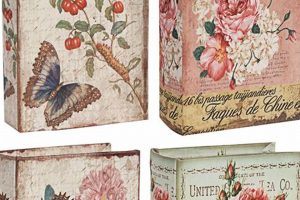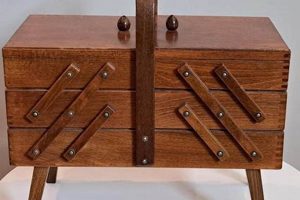Containers constructed from wood, featuring detailed ornamentation produced manually using carving tools, and possessing characteristics indicative of a previous era, represent a distinct category of decorative and functional objects. These items often exhibit unique artistry and construction techniques reflective of the period in which they were created. As an example, a small, lidded container displaying intricate floral patterns and a patina consistent with age falls under this classification.
The significance of these crafted objects lies in their connection to history and culture. They serve as tangible links to past artisans and their skills, offering insights into design aesthetics and societal values of different time periods. Furthermore, their durability and enduring beauty contribute to their desirability as collectibles and decorative accents, offering both aesthetic appeal and potential investment value.
The subsequent sections will delve into various aspects of these objects, including identification techniques, common wood types employed in their creation, prevalent carving styles, and conservation methods appropriate for preserving their integrity.
Tips for Identifying and Preserving Hand-Carved Wooden Boxes
The following guidelines are intended to assist in the identification, assessment, and preservation of wooden containers exhibiting characteristics of age and hand-carved embellishments. These recommendations promote responsible handling and maintenance of these historically significant items.
Tip 1: Examine the Wood Species. Different wood types possess distinct grain patterns, densities, and colors. Understanding the characteristics of wood like oak, pine, walnut, or rosewood can aid in determining the origin and age of the box. Consult reference guides to compare the wood’s features with known species.
Tip 2: Assess the Carving Technique. Hand-carved details exhibit subtle irregularities and tool marks not found in machine-made reproductions. Observe the depth, precision, and style of the carving to identify potential indicators of age and authenticity. Look for variations in the lines and the presence of minor imperfections inherent in hand-crafted work.
Tip 3: Evaluate the Joinery. Hand-cut dovetails, mortise-and-tenon joints, or other traditional joinery methods suggest a pre-industrial manufacturing process. Examine the precision and fit of the joints; variations in tightness or alignment can be expected in older pieces.
Tip 4: Investigate the Hardware. Hinges, latches, and other metal components can provide clues about the box’s age and origin. Research the styles and materials used in hardware from different periods to ascertain if the hardware is original to the box or a later replacement.
Tip 5: Analyze the Patina and Finish. The accumulated layers of dirt, wax, and polish, known as patina, provide visual evidence of age. A genuine patina will exhibit subtle variations in color and texture. Avoid harsh cleaning methods that can strip away this valuable indicator of authenticity.
Tip 6: Document Provenance. Whenever possible, trace the history of the container through previous owners or documented sales. Provenance adds significant value and credibility to the item.
Tip 7: Employ Proper Storage. Maintain consistent environmental conditions to prevent warping, cracking, or insect infestation. Avoid direct sunlight, excessive humidity, and drastic temperature fluctuations. Consider using archival-quality storage materials to protect the box from dust and physical damage.
Adherence to these guidelines promotes the responsible appreciation and preservation of wooden containers exhibiting both age and hand-carved characteristics, safeguarding these artifacts for future generations.
The subsequent section will address restoration considerations and professional conservation practices for these objects.
1. Wood Species Identification
Wood species identification constitutes a fundamental element in the evaluation and authentication of wooden containers exhibiting characteristics of age and hand-carved embellishments. The selection of a particular wood type directly influences the carving process, aesthetic qualities, and structural integrity of the finished piece. Consequently, accurate wood species identification provides vital clues regarding the origin, age, and potential value of the artifact. For instance, a box constructed from rosewood, known for its density and intricate grain patterns, would likely indicate higher craftsmanship and potentially a more luxurious origin compared to a box fashioned from pine, a softer wood more readily available and typically employed in simpler designs. The type of wood used can determine the types of carving that can be done to it.
The process of identifying wood species involves careful examination of grain patterns, color variations, density, and specific anatomical features visible under magnification. Comparison with established reference materials, such as wood identification guides and databases, is essential for accurate classification. Certain wood species, like mahogany or ebony, were frequently associated with specific historical periods or geographical regions, further aiding in contextualizing the artifact. For example, the prevalence of oak in Northern European furniture-making traditions makes it a common wood to find in hand-carved wooden boxes from that region. Understanding the physical properties of different woods also reveals their suitability for detailed carving; hardwoods, such as walnut or cherry, allow for finer detailing than softer woods like basswood.
In summary, the ability to accurately identify wood species forms a cornerstone of authenticating and appreciating wooden containers exhibiting both age and hand-carved characteristics. It not only reveals insights into the artifact’s origin and craftsmanship but also informs appropriate conservation methods. The accurate Wood Species Identification helps the collector appreciate the artifacts that they are trying to add in their vintage hand carved wooden boxes.
2. Carving Style Analysis
Carving style analysis represents a critical component in understanding, authenticating, and appreciating wooden containers possessing characteristics of age and hand-carved embellishments. The specific techniques employed in the creation of these objects offer invaluable insights into their origin, historical context, and the skill of the artisan.
- Regional Influences
Distinct geographical areas often developed characteristic carving styles. For example, Swiss Black Forest carvings frequently feature deeply carved depictions of animals and foliage, whereas Scandinavian styles often emphasize geometric patterns and stylized floral motifs. Identifying regional influences can help pinpoint the origin of a given piece.
- Historical Periods
Different eras favored particular carving techniques and aesthetic trends. The Renaissance, for instance, witnessed a resurgence of classical motifs and intricate detailing, while the Arts and Crafts movement emphasized simpler, more naturalistic designs. Dating a carving style can offer clues to the age of the box.
- Tool Marks and Techniques
Close examination of the carving reveals the tools and techniques employed. Hand-carved items exhibit subtle irregularities and variations in depth and texture not found in machine-made pieces. Identifying tool marks can distinguish authentic pieces from reproductions.
- Motifs and Symbolism
The motifs and symbols incorporated into the carving can convey specific meanings or reflect cultural beliefs. Religious symbols, heraldic crests, and allegorical figures were commonly used to decorate boxes and communicate messages. Interpreting these symbols provides insights into the box’s intended purpose and the values of its owner.
Ultimately, carving style analysis is not merely an aesthetic exercise; it provides a tangible link to the past, enabling a deeper understanding of the craftsmanship, historical context, and cultural significance of wooden containers with hand-carved details. These insights transform these objects from simple containers into artifacts that tell stories about the artisans who created them and the societies in which they lived.
3. Joinery Techniques Evaluation
The assessment of joinery techniques forms a crucial aspect of evaluating wooden containers exhibiting both age and hand-carved embellishments. The methods used to connect the individual components of a box not only determine its structural integrity and longevity but also provide valuable insights into its age, origin, and the skill level of the craftsman. Analysis of joinery details can distinguish mass-produced items from handcrafted pieces and can help determine if repairs or alterations have been made.
- Dovetail Joints
Dovetail joints, characterized by interlocking wedge-shaped projections, represent a hallmark of skilled craftsmanship. Hand-cut dovetails exhibit slight irregularities and variations in spacing, differentiating them from machine-made joints. The presence and quality of dovetail joints can be a strong indicator of a box’s age and value. For instance, finely executed dovetails often suggest a higher-quality piece from a period when skilled labor was more readily available.
- Mortise and Tenon Joints
Mortise and tenon joints, where a projecting tenon fits into a corresponding mortise (hole), represent another traditional joinery method. Variations in the shape and construction of mortise and tenon joints can provide clues about the box’s origin and date. A pegged mortise and tenon, for example, indicates additional reinforcement and careful construction, reflecting a higher level of craftsmanship.
- Butt Joints
Butt joints, the simplest form of joinery, involve joining two surfaces edge-to-edge. While easier to execute, butt joints are inherently weaker and less durable than dovetail or mortise and tenon joints. The presence of butt joints, particularly in conjunction with nails or screws, may suggest a more utilitarian purpose or a later date of manufacture. However, well-executed butt joints reinforced with glue and fasteners can still be found in functional, albeit less ornate, boxes.
- Nail and Screw Analysis
The type and style of nails or screws used in the construction of the container are another clue about when the item was created. Hand-wrought nails suggest an earlier date, whereas machine-made nails were invented and came into common usage in the late 1700s and 1800s. The type of screw head, the style of the thread, and material also can tell us about time-period and place of manufacturing and can assist in proper evaluation of the quality of the Joinery Techniques.
Evaluating joinery techniques, therefore, extends beyond merely assessing the structural soundness of a wooden container. It serves as a gateway to understanding its history, craftsmanship, and cultural context, enriching the appreciation of these tangible links to the past.
4. Hardware Authenticity Assessment
Hardware authenticity assessment plays a critical role in the comprehensive evaluation of wooden containers exhibiting characteristics of age and hand-carved embellishments. The hinges, latches, locks, escutcheons, and other metal components affixed to these boxes provide valuable evidence regarding their age, origin, and overall authenticity. Verifying the originality and period-appropriateness of hardware is essential for accurate dating and valuation.
- Material Composition
The materials used in hardware construction offer significant clues. Brass, iron, steel, and other metals were employed in different eras. For example, hand-wrought iron hinges are generally indicative of earlier construction, whereas machine-made brass hinges suggest a later period. Analyzing the metal’s composition through visual examination and, if necessary, scientific testing can aid in determining its authenticity.
- Manufacturing Techniques
Hardware manufacturing techniques evolved over time. Hand-filing, casting, and machine-stamping each leave distinct marks. Hand-filed hinge knuckles or cast brass pulls often exhibit subtle variations and imperfections not found in mass-produced items. Examining these details under magnification can help differentiate authentic hardware from later replacements.
- Style and Design
Hardware styles and designs reflect the prevailing aesthetic trends of specific periods. For instance, ornate Victorian-era escutcheons differ significantly from the simpler, more functional designs of the early 20th century. Researching historical hardware catalogs and reference materials can help determine if the style and design of the hardware are consistent with the box’s purported age.
- Patina and Wear
The patina and wear patterns on hardware provide further evidence of age and authenticity. Genuine patina develops over time due to oxidation and handling. Uniform or artificially applied patina may suggest that the hardware is a reproduction or has been altered. Examining the patina under magnification and comparing it to the surrounding wood can help assess its authenticity.
The insights gained from hardware authenticity assessment contribute significantly to the overall evaluation of wooden containers exhibiting age and hand-carved characteristics. By carefully examining the materials, manufacturing techniques, style, and patina of the hardware, it is possible to determine its originality and period-appropriateness, thereby enhancing the understanding and appreciation of these artifacts.
5. Patina Examination
Patina examination constitutes a critical methodology in the authentication and evaluation of wooden containers exhibiting age and hand-carved embellishments. The surface characteristics of these objects, altered by time and environmental exposure, provide valuable evidence concerning their history and authenticity. Analyzing patina helps distinguish original surfaces from later alterations or reproductions.
- Surface Oxidation and Discoloration
Over time, wood surfaces undergo oxidation and discoloration due to exposure to air, light, and moisture. The resulting patina manifests as a gradual darkening or yellowing of the wood, creating a subtle color variation. An original patina will exhibit a consistent and natural progression of these changes, while artificial aging techniques often produce uneven or unnatural coloration. For example, the gradual darkening of a shellac finish on a wooden box exposed to sunlight over decades is a sign of authentic patina.
- Accumulation of Dirt and Residue
The accumulation of dirt, dust, and polish residue in crevices and carvings contributes to the formation of patina. This accumulation occurs over decades or centuries, creating a complex layering of materials that adheres to the surface. Examining the composition and distribution of this accumulated material can reveal insights into the object’s history and environment. For instance, the presence of beeswax polish residue in the fine details of a carving is a potential indicator of consistent care over an extended period.
- Wear Patterns and Abrasion
Patina also reflects the wear patterns resulting from handling and use. Abrasion, scratches, and other surface imperfections accumulate over time, creating a distinctive texture. The distribution and severity of these wear patterns can indicate how the object was used and handled. For instance, wear marks around a box’s latch or handle may suggest frequent use, while uniform wear across the surface may result from regular cleaning or polishing.
- Finish Degradation
The deterioration of finishes, such as varnish, lacquer, or wax, contributes to the overall patina. Finishes may crack, chip, or flake over time, revealing the underlying wood. The nature and extent of this degradation provide clues about the type of finish used and its age. For instance, the characteristic “alligatoring” pattern of aged varnish is a visual indicator of authentic patina. The accurate assessment of varnish is helpful when we analyze vintage hand carved wooden boxes.
Patina examination, therefore, represents a multifaceted approach to understanding the history and authenticity of wooden containers exhibiting both age and hand-carved characteristics. By carefully analyzing the surface oxidation, accumulation of dirt, wear patterns, and finish degradation, it is possible to distinguish original surfaces from later alterations and to gain valuable insights into the object’s past.
Frequently Asked Questions
The following addresses frequently encountered inquiries regarding wooden containers characterized by their age, hand-carved embellishments, and historical significance. These answers seek to clarify common points of confusion and provide informed perspectives on these objects.
Question 1: How can the age of a wooden box be determined?
The age assessment involves analyzing several factors. These encompass the wood species, joinery techniques, hardware styles, and the presence of a genuine patina. The wood can be identified by its distinct grain patterns, densities, and colors with comparison to reference guides for known species, indicating origin and period. Carving styles and joints, as well as patina and wear, are all also important.
Question 2: What distinguishes a hand-carved box from a machine-made replica?
Hand-carved items exhibit subtle irregularities and tool marks not present in machine-made reproductions. The depth, precision, and style of the carving provide indicators of authenticity. Variations in lines and minor imperfections should be anticipated in handmade work.
Question 3: How should a vintage hand-carved box be cleaned and maintained?
Gentle cleaning with a soft, dry cloth is recommended to remove dust and debris. Avoid harsh chemicals or abrasive cleaners that can damage the finish or wood. Maintaining stable environmental conditions, away from direct sunlight and extreme humidity, is crucial for preservation.
Question 4: What wood types are commonly used in antique hand-carved boxes?
Common wood species include oak, walnut, mahogany, rosewood, and pine. The choice of wood often reflects regional availability, cost, and the intended purpose of the box. Hardwoods, such as walnut and mahogany, are frequently selected for intricate carvings.
Question 5: How does hardware contribute to the value and authenticity of a box?
Original hardware, including hinges, latches, and locks, provides valuable clues about the box’s age and origin. The style, material, and manufacturing techniques used in the hardware’s construction should be consistent with the box’s purported period.
Question 6: What factors influence the monetary value of a vintage hand-carved box?
Monetary value is determined by several factors: the rarity of the wood and carving style, the quality of the craftsmanship, the condition of the box, and its historical provenance. Pieces with documented histories or unique designs command higher prices.
In summary, the evaluation of these containers requires a comprehensive understanding of wood types, carving techniques, joinery methods, hardware authenticity, and patina analysis. Careful consideration of these elements ensures an informed appreciation of these historical artifacts.
The subsequent section will provide guidance on identifying reputable dealers and auction houses specializing in these objects.
Conclusion
The preceding exploration of vintage hand carved wooden boxes has illuminated key aspects of their identification, authentication, and preservation. Examination of wood species, carving styles, joinery techniques, hardware, and patina provides a comprehensive framework for evaluating these artifacts. Differentiation between hand-crafted and machine-produced items hinges on discerning subtle nuances in craftsmanship, tool marks, and surface characteristics. Preserving these objects necessitates careful handling, appropriate storage conditions, and the avoidance of harsh cleaning agents.
The enduring appeal of vintage hand carved wooden boxes lies in their embodiment of historical craftsmanship and cultural values. Continued diligent study and conscientious preservation efforts are crucial for ensuring that these tangible links to the past remain accessible for future generations. By applying the knowledge presented herein, collectors, historians, and enthusiasts can contribute to the appreciation and safeguarding of these unique cultural assets.







